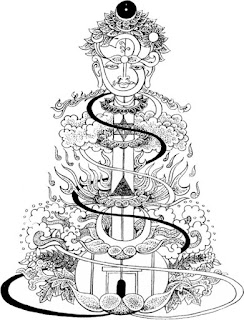 |
| The mind in recognition of the truth is the eternal guru Padmasambhava, the lotus-born. |
Truth is the term used to define that which exists in a self-evident manner. We utilize our senses to detect the existence of external bodies such as people, places, and things. We also have our inner senses, used to experience emotions, thoughts, memory, and even our identities. Those things which are experienced as existing across time, place, and person, are called truth.
In the eastern traditions, there is a hierarchy of truths depending on how pervasive they are in our everyday/ordinary experience.
 |
| The earth element, linked to sensation and the external world of matter. |
The most base level truth is that of solid matter, the element of earth experienced during the waking state through the five senses. So, therefore it is seen that earth is referred to as a fundamental truth.
 |
| The water element, linked to emotions and feelings. |
The next obvious level of truth is that of emotion or feeling based on the external stimuli in our environment. This is termed as the water element and since feelings and emotions can and are experienced with or without external stimuli, they are a higher truth.
 |
| The element of fire, linked to the thinking process. |
Above this is the fact that we are constantly thinking. Our Minds are constantly processing information, feelings, stimuli, and we engage in a sort of inner dialogue that is very difficult to stop. This is the element of fire, burning brightly in our mind as the faculty of digesting and storing the material we consume every day, helping us to make sense of our conscious and dream experiences.
 |
| The element of air linked to the concept of value systems |
Air then is also even beyond thought and fire because it is the level which holds our judgements, values, and overall direction of focus. We hold deep within us a set of values and core beliefs which guide our actions and inform us of our standing as either good or bad people. This level of truth is so pervasive it doesn't even need conscious attention for it have impacts on the way we experience, feel, think about our world and the incoming sensory stimuli or narrative structure.
 |
| The element of space which is linked to the concept of Identity |
Next, we all feel that we are the centre point of our conscious experience, the witness of life revolving around us, this is an inescapable experiential fact. This is the level of space and emptiness and from that space comes the emergence of Identity, that truth which claims the limited experiences of a particular point of space and body to be its own story or lifetime. Taking on a name, a form, a past, a family, a culture, a religion, as integral parts of its being.
 |
| The combined form of Shiva and Shakti linked to the interplay of consciousness and matter |
That is the story of the individual, but more broadly speaking we can evaluate there are two truths at play, the watcher and the watched. In tantra, we call this Shiva-shakti, or the eternal male and female polarities, Consciousness and matter.
![A Buddha named Kalacakra - Wheel of Time - with his partner (also herself a buddha). The male (yab) is method/compassion, the female (yum) is is wisdom. [Tibetan Vajrayana Buddhism]](https://i.pinimg.com/564x/7c/8f/d7/7c8fd715ecf9ab32d8b4b85b177c3c35.jpg) |
| The Tibetan illustration of the union of time and desire, Kalachakra. |
That is still not the end, as there is the space within which both of those exist, the womb of life so to speak, called time. But time does not move independently as it is impelled to move by the force of its own nature called desire.
 |
| The Self, linked to the totality of all experiential possibility, transcending time, desire, and everything which proceeds from them. |
And even Time and desire must be held up by some force capable of containing not just themselves but all the elements which emerge as a consequence of their interactions. All these principles if personified, would refer to themselves as "I", and thus all truths have their own unique "I" or Self. It is the self which is the most pervasive, most constant, and most true.
 |
| Krsna, the perfect representation of the full principle of Self, beautiful, charming, and artistic. Viewing reality in his image causes love to blossom in our being. |
Thus, the key principle or supreme tattva is not the material ingredients, nor the individual ego, not space, nor time, nor even desire, but the SELF of all beings, all concepts, and all things. That SELF which experiences all past, present, and future, of all time and space, that is the true and supreme one, the king of kings, lord of lords, the friend of friends, lover of lovers, the supreme amongst all hierarchies, all species of life, etc etc etc. That Self, most call god...I call Krsna because it is through the lens of Krsna's personality that I see life and reality as something I can and want to love more every day. Through the lens of loving Krsna, I can handle the burden of eternal existence and suffering without fail or resentment. It is through love that life gains meaning.
Until next time...
#jainitai







![A Buddha named Kalacakra - Wheel of Time - with his partner (also herself a buddha). The male (yab) is method/compassion, the female (yum) is is wisdom. [Tibetan Vajrayana Buddhism]](https://i.pinimg.com/564x/7c/8f/d7/7c8fd715ecf9ab32d8b4b85b177c3c35.jpg)




Comments
Post a Comment